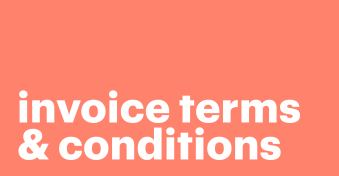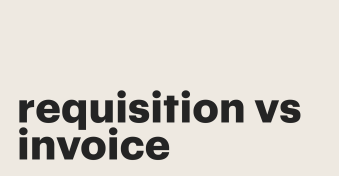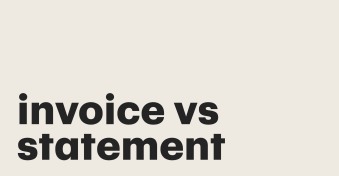Invoices and bills are two sides of the same coin. Essentially, both documents are:
- Created to show proof of payment request.
- Made with the specific purpose of requesting payment.
- Required so that businesses can get paid.
- Created by the seller or the merchant who sold the product or service.
So, it’s established that in the Venn diagram of payment-related documents, invoices and bills merge together in many ways.
One might even question where the similarities stop, and where the differences begin. If you’re questioning the exact same thing, this article is for you.
Here, we’re detailing for our readers exactly what bills and invoices are, and how to differentiate between the two.
| Bills | Invoices | |
|---|---|---|
| Persons | Usually created for individual customers. | Usually created for other businesses. |
| Elements | Smaller in size, and contain a few basic details. | Larger by comparison, and have multiple elements. |
| Due Dates | Require immediate payment. | Payment depends on payment terms. |
| Occurrence | Occurs as soon as the task is done. | Occurs at timely intervals (e.g., end of month, end of project, etc.). |
| Project Scope | Usually created for short-term and one-time tasks. | Usually created for long-term projects. |
What’s an invoice, and what does it have?
An invoice, also known as a sales invoice, is a commercial document made by business owners and freelancers to request payment from their clients.
These documents are usually sent when a project has been completed, a milestone has been achieved, or at timely intervals (e.g., at the end of the month, bi-monthly, etc.).
When you send your invoice depends upon the agreement you have with your clients.
Likewise, when you receive payment for your invoice also depends upon the agreement you have with your clientele (which is why it’s always beneficial to have a contract in place stating all payment terms, conditions, payment options, the scope of the project, and other such details).
Users can also amend the conditions of a contract with respect to invoicing (e.g., under “Payment Terms,” you can write due dates, payment methods, or charges like late fees).
Unlike bills, invoices are also more detailed, usually containing elements such as:
- A unique invoice number
- Payment terms
- Total amount due
- An itemized list of all products, quantities, description of the products, price of each product, etc.
- Charges such as discounts, taxes, and interest fees
- Customer name and billing address
- Company branding
- Contact information
- Invoice date
Invoices can also be of different types and be produced for different purposes.
For example, some invoices are recurring, whereas others are developed for one-time transactions.
What’s a bill, and what does it have?
Bills, on the other hand, are documents merchants create for business transactions to signify the amount of money a customer owes them.
While an invoice is more detailed, a bill only states the basics, such as:
- Name of the product/service (and its subsequent price and quantities)
- Total amount owed
- Name of customer
- Name and information of the business
The purpose of a bill is to get paid as soon as the seller delivers the product or service and to serve as proof of payment and completed transaction.
Bills are mostly used by grocery marts, restaurants, shopping stores, and hotels, whereas invoices are prepared for clients.
Bill vs. Invoice: What are the key differences between the two?
| Invoice | Bill |
|---|---|
| Usually made for businesses | Usually made for individuals |
| Is more detailed | Not as detailed in comparison |
| Payment depends on payment terms | Requires immediate payment |
| Is usually prepared at timely intervals | Created once the product/service is delivered |
| Made for large-scale jobs | Made for small-scale jobs |
Getting to the crux of the topic, let’s discover the key differences between a bill and an invoice.
1. By and for whom
Invoices are specifically created for clients (aka, other businesses both large and small, freelancers, corporations, or individuals) — that’s to say, all other entities who may also have their own business and use invoices to track payments, maintain records, and for accounting purposes.
Invoices can be created by small businesses, large businesses, contractors, freelancers, and anyone else who produces a product/service for you.
Bills, on the other hand, are created by merchants, such as grocery shops, restaurants, department stores, and shopping complexes, and they are generated for customers (these customers are usually individual entities, not a business).
2. Content and structure
In terms of content and structure, invoices are more detailed.
They include aspects like the invoice number, an itemized list of products, description of each product, quantities, prices, etc. (and might even include more details depending on the type of the invoice — e.g., a commercial invoice may include shipment details, too).
Bills are not as long as invoices.
They cover basic details like product name, quantity, price, and total. Some bills may provide more context, but it’s not a necessity to do so.
Bills and invoices may also use different paper sizes when printing.
For example, bills are smaller in size, whereas invoices are generally longer in size.
3. Payment due date
One of the main differences between the two is that a bill requires an immediate payment and is produced as soon as the client purchases the product.
Invoices, on the other hand, can have different payment terms, such as Net-30 days (which means that the client will have to pay within 30 days), or payment can be requested upon receipt (which means the client will have to make immediate payment), or it can have 15 MFI payment terms (which means clients will have to pay on the 15th of the following month).
To learn more about invoice payment terms, use this resource to your advantage: Invoice terms and conditions examples.
4. Occurance of delivery
Bills are produced and delivered as soon as the client has the product/service delivered to them.
For example, once you’re done dining, the restaurant you’re visiting will create a bill and present it to you; likewise, when you get services at a salon, they’ll present you with a bill immediately (and in both instances, you’ll have to pay on the spot).
Conversely, an invoice can be created at timely intervals.
For example, you may create an invoice once you deliver the product/service to the client, or as you achieve project milestones, or at the end of the month, or at other intervals (based on whatever your agreement with the client is).
5. Length and scope of projects
While not a necessity, invoices are generally created for large-scale jobs or projects that last a long period of time.
For example, an invoice may be generated if a project is two months long.
On the opposite end of this coin, bills are created for purchases that happen in an instant.
For example, a bill is created as soon as you purchase groceries or grab some food to go.
Why are they created, and what are the consequences of not sending invoices or bills?
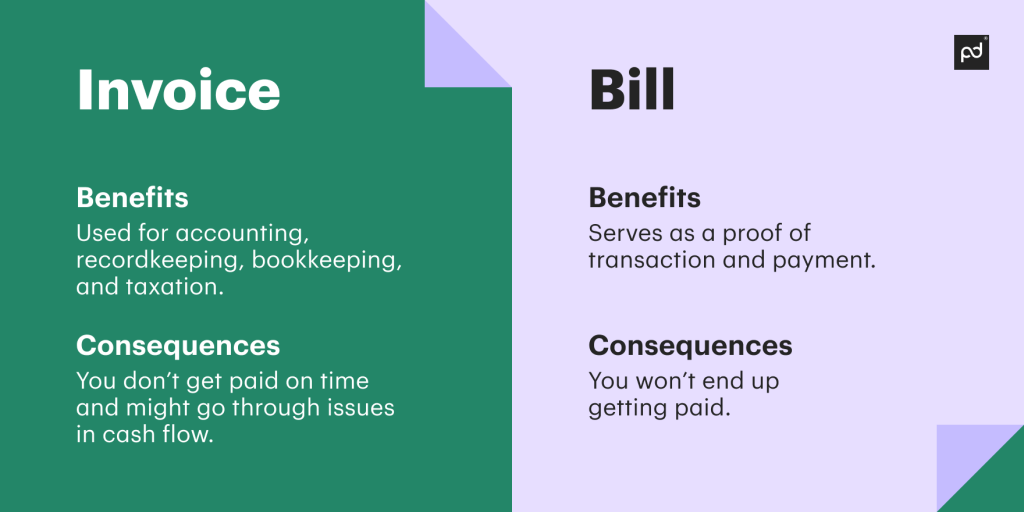
Second guessing why you should be creating invoices and bills? Do you want to know the benefits of generating them — and the consequences if you don’t?
Well, look no further! We’re uncovering why it makes sense to create these docs and send them out, and possible repercussions of opting not to do so.
The primary benefit of creating a bill is that it serves as proof that a transaction has been made (and it may be stamped with a “paid” imprint to indicate that payment has, in fact, been applied).
Invoices serve a wider purpose by comparison.
Aside from keeping a record of the transaction that took place, invoices also help with other tasks, such as keeping the cash flow moving, giving timely updates of the total amount due to clients, providing data for taxation, bookkeeping, and accounting purposes, etc.
The possible consequences of not sending an invoice are the inverse of its benefits.
For example, you run into the worry of not getting paid on time, not keeping your clients updated, not having the data for accounting and taxes, not having a steady cash flow, and not registering any transactions.
In a related way, if you don’t send bills out on time, you might not get paid for the products/services you delivered to the client.
From a legal perspective, there are some situations where invoices and bills are explicitly required.
For example, you cannot export certain products if you don’t have a commercial invoice with a DCS statement.
Similarly, if you’re selling your products to a foreign individual, they’ll need a bill to get a tax refund at the airport.
How and where to create invoices and bills
Now that we’ve covered the key differences between invoices and bills, let’s get to the meatier bits and uncover how and where you can create these important documents.
How to create an invoice
To create an invoice, the most efficient option is to use invoicing software.
For example, solutions like PandaDoc have a readymade template library of different types of invoices (e.g., pro forma invoice, commercial invoice, blank invoice, etc.)
You can simply edit the template with the necessary details and pass it along to your client.
What’s more is that you can also track these invoices to get unique insights.
Alternatively, you can even create invoices from scratch.
To know which invoicing solution is the best for your business, you can use this resource: 16 best invoicing software options to facilitate your payment process.
You can also use:
- Solutions like Microsoft Word (it has readymade invoice templates, too).
- Try your hand at Canva (it has both free and premium templates for all types of businesses).
- Explore the features of your payment platform (some payment platforms like Payoneer and Wise allow users to create an invoice on the platform itself).
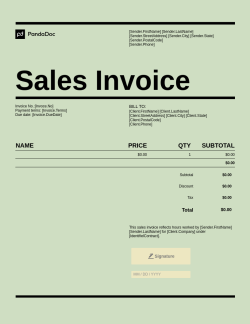
Sales Invoice Template
Used 5437 times
Use this professional sales invoice template as a sample on which to base all the sales invoicing of your product or service.
Use this templateHow to create a bill
Businesses can use accounting software to create bills easily.
Or, if that doesn’t tickle your fancy, you can try using PandaDoc’s editor, Microsoft Word, or Google Docs to create bills from scratch.
Before purchasing accounting software, please check to make sure it complies with the regulations of the state/country you belong to.
For example, businesses in the United States use taxes. But on the other side of the world, in India, as per country laws, you need to use GST (which is a form of taxes), and the solution you use has to be GST-compliant.
Wrapping up
And that wraps up our list of key differences between an invoice and a bill!
Differentiating between the two is a little tricky, we’ll give you that.
However, producing both documents and getting paid on time need not be tricky.
To increase your chances of easily producing invoices, you’re best off implementing an easy-to-use solution that understands your requirements and is highly intuitive.
And to accelerate getting paid on time, you should use a solution that lets you add multiple text, signature, media, and photo fields, and has a library of readymade templates that you can refer to.
Lucky for you, PandaDoc can deliver on both accounts.
Our solution is specifically built to be easy to use, efficient, and highly adaptable.
The best part? You can just create a free eSign account to get started.
And if you wish to explore further capabilities, you can arrange a call with a PandaDoc representative, who’ll take you on a quick walkthrough of the product.
Disclaimer
PandaDoc is not a law firm, or a substitute for an attorney or law firm. This page is not intended to and does not provide legal advice. Should you have legal questions on the validity of e-signatures or digital signatures and the enforceability thereof, please consult with an attorney or law firm. Use of PandaDocs services are governed by our Terms of Use and Privacy Policy.
